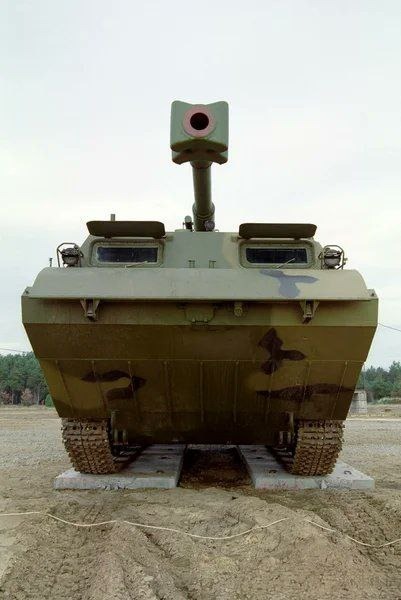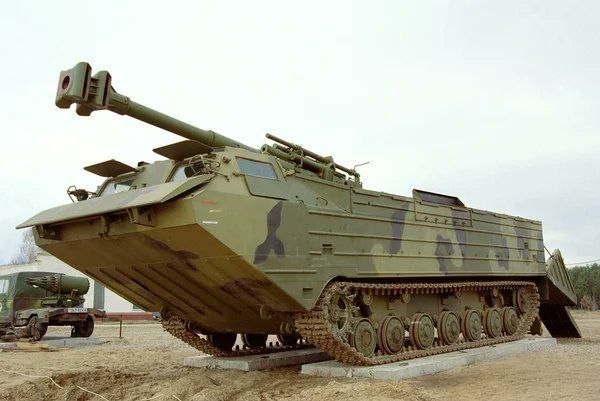
In 1998, at the Honcharivske training ground (Chernihiv region), one could see a very interesting sample of a towed artillery system with an unusually shaped muzzle brake installed on a PTS-2 amphibious full-track vehicle. It was the muzzle brake that made it possible to track the “pedigree” of the howitzer: it came from the late Soviet 2А61 Pat-B artillery system.
The Pat-B 152mm howitzer was created as a more powerful and modern replacement for D-30 122mm howitzers in the regimental level unit. A similar predecessor was the construction of a gun carriage, which provided a gun direction of 360 degrees (the gun elevation range was from -5 to +70 degrees). The gun carriage was strengthened to withstand the increased recoil force. However, that doesn’t solve the problem, and therefore they had to install the muzzle brake twice mentioned in this article on the barrel.
The ballistics of the 2А61, according to the Russians, is “identical to the ML-20 howitzer-gun with cartridge No. 3.” In practice, this means that in terms of range (15200 m), it slightly predominates the archaic (born in 1943) D-1 152mm howitzer, but at the same time weighs 750 kg more (4350 kg). The comparison with the American “Triple-Seven” Pat-B does not stand at all: the М777 weighs 4200 kg, but fires as much as 24,000 m (a standard projectile, not rocket-assisted).

Pat-B successfully passed the test in 1991 and was even recommended for serial production, but… that was the end of it. Of the six prototypes produced, three ended up in museums. Self-propelled versions did not fall into the series – the 2S18 Pat-S on the BMP-3 chassis (although recently information has appeared about the possible “resuscitation” of this project) and the 2S26 Pat-K on the Ural-5232 truck chassis. Also, the М-389 export version of the Pat-B with the barrel of the NATO standard (155mm, 39 calibers) was not produced at all.
Where did this unique thing in Ukraine come from? In the 1990s, the State Scientific and Technical Center for Artillery and Small Arms of Ukraine created its version of Pat-B, called КBА-27. In fact, they cloned only the artillery part – the gun carriage was taken from the D-20 howitzer. Such a carriage made it possible to create ersatz-self-propelled guns based on the PTS-2: the howitzer was rolled into the body of the tracked amphibious transport and then fixed there (2А61 could not be used – the body would not have enough space for its gun carriage in the combat position). The self-digging tool served as support for shooting.

PTS-2 with КBА-27, together with other developments of Ukrainian artillery weapons, was demonstrated on October 28, 1998, at the Honcharuvsky training ground. There was no information about the fate of the howitzer after this show.

The question remains: how did they manage to copy this modern (for that time) artillery system? Let me share my theory: since Pat-B was approved for serial production, it cannot be ruled out that a set of technical documentation fell on one of the Ukrainian plants as a mobilization task. Based on this, a КBА-27 was created.
Dear readers, if you like my article, you can buy me a coffee here https://www.buymeacoffee.com/andrijkhar9
Підтримати нас можна через:
Приват: 5169 3351 0164 7408 PayPal - [email protected] Стати нашим патроном за лінком ⬇
Subscribe to our newsletter
or on ours Telegram
Thank you!!
You are subscribed to our newsletter